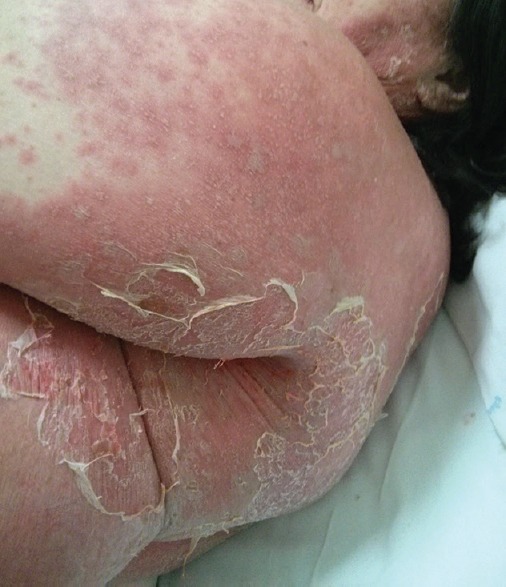Abstract
Acute generalized exanthematous pustulosis (AGEP) is an uncommon and self-limiting skin rash commonly caused by drugs and is characterized by the acute onset of fever, pustulosis, and neutrophilia from 4 to 10 days after the drug intake. We describe a case of AGEP in a 61-year-old woman that was hospitalized for the acute onset of fever, erythroderma, and pustulosis. Clinical history revealed that she had been treating a bacterial inguinal intertrigo for 4 days with ciprofloxacin 500 mg tablets twice daily and desloratadine 5 mg tablet once daily. To the best of our knowledge, this is the third reported case of AGEP caused by ciprofloxacin, supporting two other previous reports.
Key words: Adverse drug reaction, acute generalized exanthematous pustulosis, ciprofloxacin
Acute generalized exanthematous pustulosis (AGEP) is an uncommon and self-limiting skin rash commonly caused by drugs and more rarely by viral infections, the intake of toxic substances or insect bites.[1] It is clinically characterized by an acute onset of several nonfollicular and sterile pustules on erythematous edematous areas of the skin.[2] The skin lesions are often associated with fever, malaise, and neutrophilia. Diagnosis can be performed according to the “AGEP validation score of EuroSCAR study group.”[3] The onset of AGEP signs may occur from 4 to 10 days after the drug intake, depending on whether the patient had taken the same drug in the past. Therapy consists of systemic steroids and resolution is usually fast; very severe or refractory cases seem to benefit from the treatment with cyclosporine or etanercept.
Case Report
A 61-year-old woman came to our attention and was hospitalized for the acute onset of fever (38°C), erythroderma, and pustulosis; the pustules were mainly localized on her shoulders, upper arms, and trunk [Figure 1]. In the latter area, they appeared to coalesce, giving rise to wide epidermal detachments. Mucosal areas were healthy. Clinical history revealed that she had been treating a bacterial inguinal intertrigo for 4 days with ciprofloxacin 500 mg tablets twice daily and desloratadine 5 mg tablet once daily. She referred that she had already taken ciprofloxacin in the past for refractory urinary tract infections. Laboratory tests showed leukocytosis (23,000/ml, nv 3900–11700), neutrophilia (86.4%, nv 39.6–74.7), increased C-reactive protein (188 mg/l, nv <8), increased fibrinogen (505 mg/l, nv 200–400), increased D-dimers (4.8 mg/l, nv <0.5), slightly increased urea (41 mg/dl, nv 15–38), and decreased glomerular filtration rate (66 ml/min, nv >90). Skin biopsy showed a nonfollicular, subcorneal, neutrophilic pustule with eosinophils, histiocytes, mild spongiosis, and moderate papillary dermal edema.
Figure 1.

Erythroderma and pustulosis of our patient at the first day of hospitalization
The cutaneous morphology, course, histological findings, and laboratory examinations were consistent with a definite diagnosis of AGEP according to the validation score of the EuroSCAR study group; we therefore reported it to Italian pharmacovigilance. We immediately stopped the ciprofloxacin and started infusional therapy with methylprednisolone 40 mg once daily and trimeton (chlorphenamine) 10 mg twice daily. The rash significantly improved within a few days; after complete resolution of the lesions, patch tests and lymphocyte proliferation test performed with ciprofloxacin both resulted negative.
Discussion
The most important step of AGEP diagnosis is to identify the provocative agent: if it is a drug, it must be discontinued immediately, If an infection, immediately treated. Commonly, AGEP is caused by penicillins and cephalosporins,[4] sometimes by fluoroquinolones (especially norfloxacin and ofloxacin).[5] To the best of our knowledge, this is the third reported case of AGEP caused by ciprofloxacin, supporting two other previous reports.[6,7] In 2005, Knoell and Lynch reported the case of a 63-year-old man with a photoinduced acute exanthematous pustulosis (an unusual form of AGEP) caused by ciprofloxacin and exposure to ultraviolet light.[6] Diagnosis was made on the basis of clinical and histological findings. In the same year, Hausermann et al. reported another case of ciprofloxacin-induced AGEP in an 80-year-old woman who also showed a positive patch test to the drug.[7]
Patch testing with the drugs involved is a useful and noninvasive way to identify the culprit agent of AGEP but is characterized by low sensitivity, being positive in about 60% of cases. The lymphocyte proliferation test seems promising but likewise has low sensitivity. As in our case, a negative reaction to these tests should not prompt a reconsideration of the diagnosis that remains primarily clinical.
Financial Support and Sponsorship
Nil.
Conflicts of Interest
There are no conflicts of interest.
References
- 1.Bhat YJ, Hassan I, Sajad P, Yaseen A, Wani R. Acute generalized exanthematous pustulosis due to insect bites? Indian J Dermatol. 2015;60:422. doi: 10.4103/0019-5154.160529. [DOI] [PMC free article] [PubMed] [Google Scholar]
- 2.Staughton RC, Payne CM, Harper JI, McMichen H. Toxic pustuloderma – A new entity? J R Soc Med. 1984;77(Suppl 4):6–8. [PMC free article] [PubMed] [Google Scholar]
- 3.Sidoroff A, Halevy S, Bavinck JN, Vaillant L, Roujeau JC. Acute generalized exanthematous pustulosis (AGEP) – A clinical reaction pattern. J Cutan Pathol. 2001;28:113–9. doi: 10.1034/j.1600-0560.2001.028003113.x. [DOI] [PubMed] [Google Scholar]
- 4.Lin YF, Yang CH, Sindy H, Lin JY, Rosaline Hui CY, Tsai YC, et al. Severe cutaneous adverse reactions related to systemic antibiotics. Clin Infect Dis. 2014;58:1377–85. doi: 10.1093/cid/ciu126. [DOI] [PubMed] [Google Scholar]
- 5.Sidoroff A, Dunant A, Viboud C, Halevy S, Bavinck JN, Naldi L, et al. Risk factors for acute generalized exanthematous pustulosis (AGEP)-results of a multinational case-control study (EuroSCAR) Br J Dermatol. 2007;157:989–96. doi: 10.1111/j.1365-2133.2007.08156.x. [DOI] [PubMed] [Google Scholar]
- 6.Knoell KA, Lynch JM. Photoinduced acute exanthematous pustulosis caused by ciprofloxacin and sunlight exposure. Int J Dermatol. 2009;48:1141–3. doi: 10.1111/j.1365-4632.2009.04115.x. [DOI] [PubMed] [Google Scholar]
- 7.Hausermann P, Scherer K, Weber M, Bircher AJ. Ciprofloxacin-induced acute generalized exanthematous pustulosis mimicking bullous drug eruption confirmed by a positive patch test. Dermatology. 2005;211:277–80. doi: 10.1159/000087024. [DOI] [PubMed] [Google Scholar]


